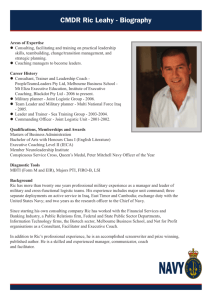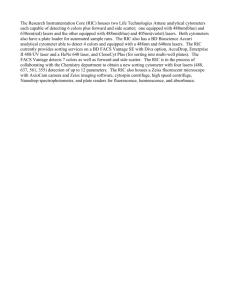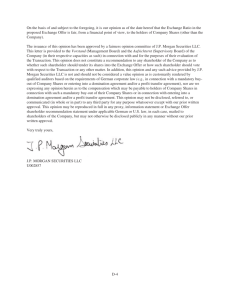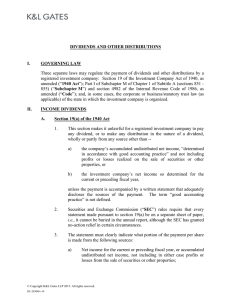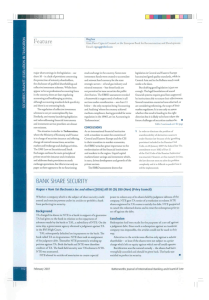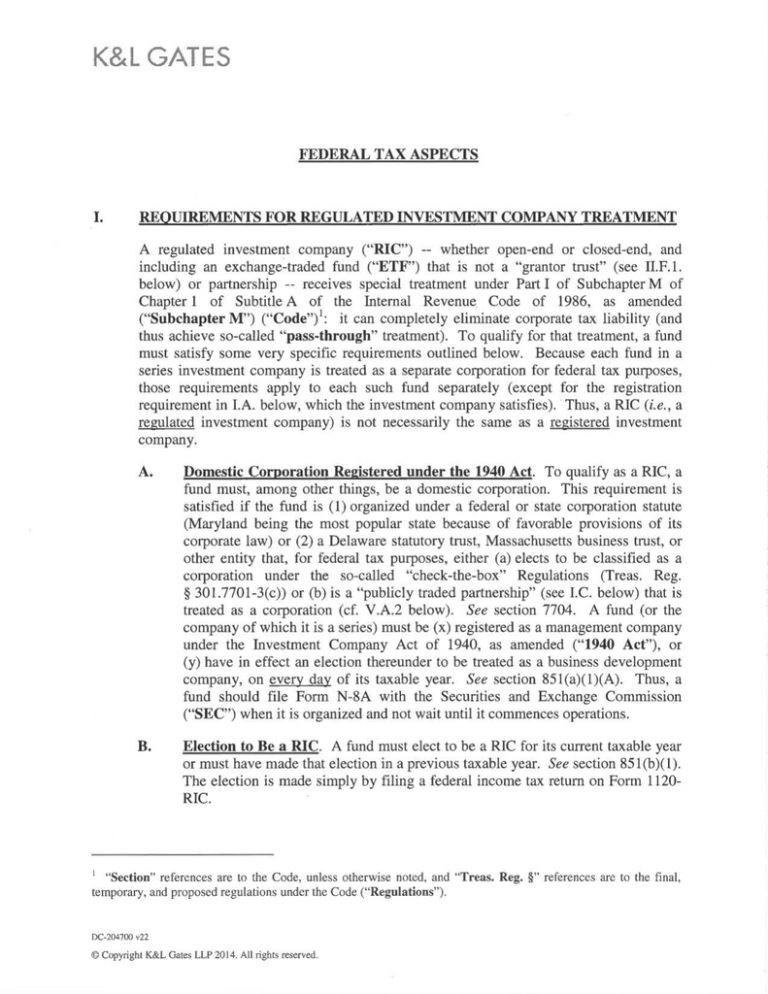
K&L GATES
FEDERAL TAX ASPECTS
I. REQUIREMENTS FOR REGULATED INVESTMENT COMPANY TREATMENT
A regulated investment company ( "RIC") -- whether open-end or closed-end, and
including an exchange-traded fund ("ETF") that is not a "grantor trust" (see II.F.1.
below) or partnership -- receives special treatment under Part I of Subchapter M of
Chapter 1 of Subtitle A of the Internal Revenue, Code of 1986, as amended
("Subchapter M") ("Code")': it can completely eliminate corporate tax liability (and
thus achieve so-called "pass-through" treatment). To qualify for that treatment, a fund
must satisfy some very specific requirements outlined below. Because each fund in a
series investment company is treated as a separate corporation for federal tax purposes,
those requirements apply to each such fund separately (except for the registration
requirement in I.A. below, which the investment company satisfies). Thus, a RIC (i.e., a
regulated investment company) is not necessarily the same as a registered investment
company.
A.
Domestic Corporation Registered under the 1940 Act . To qualify as a RIC, a
fund must, among other things, be a domestic corporation. This requirement is
satisfied if the fund is (1) organized under a federal or state corporation statute
(Maryland being the most popular state because of favorable provisions of its
corporate law) or (2) a Delaware statutory trust, Massachusetts business trust, or
other entity that, for federal tax purposes, either (a) elects to be classified as a
corporation under the so-called "check-the-box" Regulations (Treas. Reg.
§ 301.7701-3(c)) or (b) is a "publicly traded partnership" (see I.C. below) that is
treated as a corporation (cf. V.A.2 below). See section 7704. A fund (or the
company of which it is a series) must be (x) registered as a management company
under the Investment Company Act of 1940, as amended ( "1940 Act"), or
(y) have in effect an election thereunder to be treated as a business development
company, on every day of its taxable year. See section 851(a)(1)(A). Thus, a
fund should file Form N-8A with the Securities and Exchange Commission
("SEC") when it is organized and not wait until it commences operations.
B.
Election to Be a RIC . A fund must elect to be a RIC for its current taxable year
or must have made that election in a previous taxable year. See section 851(b)(1).
The election is made simply by filing a federal income tax return on Form 1120RIC.
' "Section" references are to the Code, unless otherwise noted, and "Treas. Reg. §" references are to the final,
temporary, and proposed regulations under the Code ( "Regulations ").
DC-204700 v22
© Copyright K&L Gates LLP 2014. All rights reserved.
K&L Gates LLP
C.
Gross Income Requirement .
A fund must derive at least 90% of its gross
income each taxable year from (1) dividends, interest, payments with respect to
securities loans, and gains from the sale or other disposition of securities or
foreign currencies, or other income (including gains from options, futures, or
forward contracts) derived with respect to its business of investing in securities or
those currencies, and (2) net income derived from an interest in a "qualified
publicly traded partnership" ("QPTP"). See section 851(b)(2). (A QPTP is
defined as a publicly traded partnership -- generally, a partnership the interests in
which are "traded on an established securities market" or are "readily tradable on
a secondary market (or the substantial equivalent thereof)" -- other than a
partnership at least 90% of the gross income of which consists of qualifying
income described in clause (1) above.)
Income from Commodities .
Income from direct investments in
commodities and from certain types of derivative contracts regarding
commodities, such as certain swaps on commodity indices, is not
qualifying income for the purpose of this requirement (in the case of those
contracts, because, in the view of the Internal Revenue Service
("Service"), they are not securities). See Rev. Rul. 2006-1, 2006-1 C.B.
261, modified by Rev. Rul. 2006-31, 2006-1 C.B. 1133. (That conclusion,
however, does not apply to commodities derivatives entered into "to
reduce or hedge the level of risk in a [RIC-permitted] business." See, e.g.,
private letter rulings ( "PLRs") 200440012 (May 17, 2004) (options and
futures on gold entered into to hedge long positions in shares of issuers
engaged in gold mining, processing, refining, selling, etc.) and 201319003
(Jan. 30, 2013) (futures contracts on VIX, a volatility index). 2
)
Shortly after publication of Rev. Rul. 2006-1, however, the Service began
issuing PLRs holding that (1) income and gain from certain "structured
notes that create a commodity exposure" (so-called "commodities-linked
notes") do constitute qualifying income and/or (2) income from a wholly
owned foreign subsidiary (a "controlled foreign corporation") that invests
in commodities and financial derivatives (even derivatives similar to those
that were the subject of the revenue rulings) (see PLR 201206015 (June
13, 2006, released Feb. 10, 2012 (not a typo))) also constitutes qualifying
2
Although, under section 61 10(k)(3), a PLR may not be cited as precedent, tax practitioners look to PLRs as
generally indicative of the Service's views on the proper interpretation of the Code and the regulations thereunder.
Cf. Rowan Companies, Inc. v. United States, 452 U.S. 247, 261 n. 17 (1981); Hanover Bank v. Commissioner, 369
U.S. 672, 686 (1962); Buckeye Power, Inc. v. United States, 38 Fed. Cl. 283, 285 (Claims Ct. 1997); also see Treas. Reg.
§ 1.6662-4(d)(3)(iii) (providing that PLRs issued after October 31, 1976, are authority for purposes of determining
whether there is or was substantial authority for the tax treatment of an item under section 6662(d)(2)(B)(i), in
connection with the imposition of the accuracy-related penalty under section 6662 to a substantial understatement of
income tax).
-2-
K&L Gates LLP
income. The Service issued more than seventy of those PLRs thereafter,
the most recent being PLR 201134014 (May 13, 2011) and 201135001
(May 23, 2011). In July 2011, however, the Service "temporarily"
suspended the issuance of those PLRs pending its "re-examination" of the
policies underlying them; that temporary suspension was still in effect at
the date this outline was prepared, and there have been no indications that
it will be lifted anytime soon, if at all.
Although the "Regulated Investment Company Modernization Act of
2010," as passed by the House of Representatives on September 28, 2010,
included a provision that would have treated all income from commodities
as qualifying income, that provision was eliminated from the bill as passed
by the Senate and enacted on December 22, 2010 ( "RIC Mod Act "). 3
D.
Diversification Requirements
1.
50% of Assets
At the close of each quarter of a fund's taxable year, at least 50% of the
value of its total assets must be invested in cash, cash items (including
receivables), Government securities, securities of other RICs, and (subject
to the 5% and 10% restrictions noted in a) and b) below) other securities.
See section 851(b)(3)(A). Compare the diversification requirement in
section 5(b)(1) of the 1940 Act (at least 75% of assets must be so
diversified at all times ). The other 50% of a fund's assets may be invested
in anything, subject to the 25% diversification requirement described in
D.2. below, although that may not satisfy the 1940 Act diversification
requirement.
a)
5% of assets in a single issuer. If more than 5% of the value of a
fund's total assets is invested in the securities of a single issuer, all
those securities (not merely the excess over 5%) do not qualify for
the purpose of the 50%-of-assets requirement.
b)
10% of a single issuer's voting securities. If a fund owns more
than 10% of the voting securities of a single issuer -- equity
securities of QPTPs are considered voting securities for this
purpose -- none of those securities qualifies.
The RIC Mod Act's provisions, many of which are referred to below, generally are effective for RIC taxable years
beginning after the date of its enactment.
3
-3-
K&L Gates LLP
c)
Treatment of Specific Instruments
(1)
Certificates of Deposit . The Service has ruled that short-
term CDs are cash items, not securities (though the SEC
has classified them as securities).
(2)
Bankers' Acceptances . The Service has ruled that these are
not cash items for a real estate investment trust (which is
governed by similar rules in Part II of Subchapter M);
presumably, the same treatment applies to RICs.
(3)
Repurchase Agreements . Pursuant to Rev. Proc. 2004-28,
2004-1 C.B. 984, a fund may treat a position in a repo that
is "collateralized fully" with government securities as such
securities (i.e., "good" assets) for diversification purposes.
Previously, a repo was treated for those purposes as a
secured loan (i.e., a single security issued by the
counterparty ("borrower")), not a purchase and resale of the
underlying securities; and a repo will continue to be so
treated if it fails to satisfy the revenue procedure's
requirements. Moreover, the revenue procedure does not
apply for purposes of the diversification requirement under
section 817 that applies to separate accounts on which
variable annuity and life insurance products are based.
(4)
Overnight loans of federal funds are not cash, but
securities.
(5)
There is no definition of
"Government securities" in the Code or the Regulations.
However, for purposes of the diversification requirements,
the Code adopts the definitions in the 1940 Act for any
term not defined in the Code. See section 851(c)(6).
Section 2(a)(16) of the 1940 Act defines a "government
security" as any security issued or guaranteed as to
principal or interest by the United States or by a person
controlled or supervised by, and acting as an
instrumentality of, the U.S. government pursuant to
authority granted by Congress.
Thus, for example,
Government National Mortgage Association (a/k/a "Ginnie
Mae"), Federal National Mortgage Association (a/k/a
"Fannie Mae"), and Federal Home Loan Mortgage
Association (a/k/a "Freddie Mac") mortgage-backed and
mortgage participation certificates are Government
Government Securities .
-4-
K&L Gates LLP
securities. See Rev. Rul. 92-89, 1992-2 C.B. 154, for a
short list of other Government securities; also see Rev. Rul.
2003-84, 2003-2 C.B. 289 (refunded municipal bonds, with
respect to which Government securities are placed in
escrow to fund future payments on the bonds, are
Government securities for purposes of the diversification
requirements). Options, futures, and options on futures on
Government securities also appear to be Government
securities.
2.
25% of Assets
At the close of each quarter of a fund's taxable year, not more than 25% of
the value of its total assets may be invested in (a) securities (other than
Government securities or securities of other RICs) of any one issuer,
(b) securities (excluding other RICs' securities) of two or more issuers the
fund controls that are determined to be engaged in the same, similar, or
related trades or businesses, or (c) securities of QPTPs. See section
851(b)(3)(B).
3.
No Disqualification for Certain Failures to Comply (Section 851(d))
a)
If a fund fails to meet a
diversification requirement due solely to market fluctuations,
distributions, or redemptions rather than wholly or partly because
of an acquisition, the fund will not be disqualified if it had satisfied
both diversification requirements at the close of the first quarter of
the first taxable year for which it elected to be a RIC.
Market Fluctuation Exception.
Example - A fund acquired a position in an issuer's securities
valued at that time at less than 25% of the fund's total assets. If
that position subsequently exceeded 25% of those assets at a
quarter-end because those securities increased in value more
rapidly than the fund's other assets or because the fund had to
liquidate other securities to make one or more cash distributions,
the failure to satisfy the 25% diversification requirement would not
disqualify the fund. But if it then acquired (including through a
transfer in connection with a reorganization) as little as one
additional share of that issuer's securities (even if its cost plus the
cost of the original shares still was less than 25% of the fund's
total asset value), the fund would no longer be able to rely on this
exception.
-5-
K&L Gates LLP
b)
30-Day Cure Period. If a fund's failure to satisfy a diversification
requirement at the close of any quarter is wholly or partly (see
example above) the result of an acquisition (including, in the case
of a closed-end fund, a redemption or repurchase of its own
securities!), the fund has 30 days after the close of the quarter in
which to cure the failure.
c)
E.
The RIC Mod Act enacted provisions that enable a fund to
preserve its RIC status in the case of a failure "due to reasonable
cause and not due to willful neglect" ("inadvertent failure") or a de
minimis failure to meet the diversification requirements, as well as
an inadvertent failure to meet the gross income requirement
described in I.C. above, by making certain disclosures and paying
a specially calculated tax.
Distribution Requirement
A fund that satisfies all the above requirements qualifies to be a RIC. To qualify
for the pass-through treatment of Subchapter M, however, a RIC also must
distribute to its shareholders for each taxable year at least 90% of the sum of its
"investment company taxable income" -- which generally consists of net
investment income, the excess of net short-term capital gain (essentially, net gain
from the sale or exchange of capital assets held for one year or less) over net longterm (more than one year) capital loss ( "short-term capital gain "), and net gains
and losses from certain foreign currency transactions, all determined without
regard to the dividends-paid deduction (see III. below) -- plus its net interest
income excludable from gross income under section 103(a).
See section
852(a)(1). 4 There is no requirement to distribute any "net capital gain" (i.e., the
excess of net long-term capital gain over net short-term capital loss). For these
and other purposes (see, e.g., II.A.-E. and III. below), dividends and other
distributions that (1) a RIC declares in the last quarter of any calendar year,
(2) are payable to shareholders of record on a date in that quarter, and (3) are
actually paid during the following January are deemed to have been paid by the
RIC and received by the shareholders on December 31 of that year ( "Year-end
Dividend Rule "). See section 852(b)(7).
Technically, to qualify for that treatment a RIC's dividends-paid deduction (see III. below) must be at least 90%
of that sum, and not all distributions qualify for that deduction. See, e.g., the preferential dividend rule described in
V.B.1. below.
4
K&L Gates LLP
II. TAX TREATMENT OF SHAREHOLDERS
A.
Income Dividends . A RIC's distributions to its shareholders from its investment
company taxable income (including short-term capital gain) are taxed to them,
unless they are exempt from federal income tax, as ordinary income. See section
301(c)(1). A portion of those dividends, however, may be subject to federal
income tax for individual and certain other non-corporate shareholders (each, an
"individual shareholder") at the lower rates for net capital gain -- a maximum of
15% for a single shareholder with taxable income not exceeding $406,750
($457,600 for married shareholders filing jointly) and 20% for individual
shareholders with taxable income exceeding those respective amounts (which will
be adjusted for inflation annually) ( "Maximum Tax Rates "). 5 See section
1(h)(11). The portion of a RIC's dividends subject to those rates ( "qualified
dividend income ") may not exceed the aggregate dividends the RIC receives
from most domestic corporations and certain foreign corporations (subject to its
satisfying certain holding period and other restrictions with respect to the stock on
which the dividends are paid), unless that aggregate is at least 95% of its gross
income (as specially computed), in which case the entire dividend qualifies. In
addition, the Maximum Tax Rates apply to a shareholder only if he or she
satisfies the same restrictions with respect to the RIC shares on which the
dividends are paid.
A portion of a RIC's dividends also may be eligible for the dividends-received
deduction allowed to corporations -- the eligible portion may not exceed the
aggregate dividends the RIC receives from domestic corporations subject to
federal income tax (excluding real estate investment trusts) and, unlike qualified
dividend income, excludes dividends from foreign corporations -- subject to
similar restrictions. See section 854(b). However, dividends a corporate
shareholder deducts pursuant to the dividends-received deduction are subject
indirectly to the federal alternative minimum tax.
B.
Net Capital Gain . A RIC's distributions to its shareholders from its net capital
gain, when reported as such in writing to its shareholders, are treated by them as
long-term capital gain. See section 852(b)(3)(B). (The RIC Mod Act eliminated
a requirement that capital gain dividends and certain other dividends be properly
"designated" for tax purposes, which normally was accomplished in a RIC's
annual report to its shareholders.) Similar treatment is provided for undistributed
The 15% maximum rate initially was enacted "temporarily" by the Jobs and Growth Tax Relief Reconciliation
Act of 2003 -- and repeatedly extended from the original expiration date of 2008 -- until made permanent by the
American Taxpayer Relief Act of 2012, which was signed into law on January 2, 2013. Technically, qualified
dividend income (see the next sentence in the accompanying text) is included in net capital gain (described in II.B.
below).
5
-7-
K&L Gates LLP
net capital gain. See section 852(b)(3)(D). Any distributions a RIC makes of net
capital gain it recognizes are subject to the Maximum Tax Rates for individual
shareholders. See section 1(h)(11). Note that this treatment is determined by how
long the RIC held the investments the sale of which generated the gain, not by
how long a shareholder held the RIC's shares.
C.
Exempt-Interest Dividends. If at least 50% of the value of a RIC's total assets
at the close of each quarter of its taxable year consists of obligations the interest
on which is excludable from gross income under section 103(a) -- the Service
took the position in a 1978 PLR (and continues to adhere thereto) that shares in
other RICs that satisfy this requirement do not count toward the shareholder
RIC's satisfying it (i.e., no "look-through") (but see VI.C. below) -- then the
RIC's distributions of the excess of that interest income over certain amounts
disallowed as deductions, when reported as such in writing to its shareholders
( "exempt-interest dividends "), may be excluded from gross income by its
shareholders. See section 852(b)(5).
D.
The income
dividends a RIC pays to a non-U.S. shareholder from its investment company
taxable income (which, as noted in I.E. and II.A. above, includes short-term
capital gain) generally are subject to a 30% (or lower treaty rate) federal
withholding tax. For taxable years beginning before January 1, 2014, however,
that tax did not apply to a RIC's "interest-related dividends" (i.e., distributions of
its "qualified net interest income," which is "qualified interest income" less
allocable deductions, from sources within the United States) and "short-term
capital gain dividends" (essentially, distributions of its short-term capital gain,
subject to certain adjustments), reported as such in writing to its shareholders, that
are paid to a shareholder who filed a statement (presumably a Form W-8BEN)
that the beneficial owner of the RIC's shares was a non-U.S. person, with certain
exceptions. See sections 871(k), 881(e), 1441(c)(12), and 1442(a). That
exemption from that withholding tax originally applied only to taxable years
beginning after December 31, 2004, and before January 1, 2008, but the expiration
date has periodically been extended for one or two years each time; it is expected
that if and when Congress enacts certain "tax extenders," it will be extended again.
E.
Foreign Taxes. If more than 50% of the value of a RIC's total assets at the close
Interest Related and Short-Term Capital Gain Dividends.
-
of any taxable year consists of securities of foreign corporations, the RIC may
elect to pass-through to its shareholders any foreign withholding, income, and
similar taxes it pays, with respect to which the shareholders may be able to claim
a foreign tax credit or deduction on their own income tax returns. See section
853. Generally, this pass-through treatment will be available only to funds that
invest primarily in foreign securities. But see VI.C. below.
K&L Gates LLP
F.
Disposition of Shares
1.
Taxable Gain or Loss. When a shareholder redeems an open-end RIC's
shares or sells a closed-end fund's or ETF's shares on an exchange, the
shareholder will recognize taxable gain or loss, measured by the difference
between the redemption/sale proceeds and the shareholder's adjusted basis
in the redeemed/sold shares (or, in the case of an ETF that is treated for
federal tax purposes as a "grantor trust," the shareholder's share of the
ETF's underlying assets), which normally includes any sales charge paid
on them. An exchange of RIC shares for shares of another RIC (usually
permitted within fund complexes without payment of sales charges) -- not
to be confused with conversion of shares from one class of a RIC to shares
of another class of the same RIC (which generally is not a taxable event) -normally will have similar tax consequences. Any capital gain an
individual shareholder recognizes on a redemption or exchange of shares
that have been held for more than one year will qualify for the Maximum
Tax Rates. The legislation that enacted those rates did not change the tax
rate on short-term capital gain, which continues to be taxed at the ordinary
income rate.
2.
Disposition of Certain Shares. If a shareholder disposes of a RIC's
shares ("original shares") within 90 days after purchase thereof and, by
January 31 following the year of the disposition, reacquires shares of that
RIC or acquires shares of another RIC on which a sales charge normally is
imposed ("replacement shares"), in either case without paying the sales
charge (or paying a reduced charge) due to an exchange privilege or a
reinstatement privilege, then (a) any gain on the disposition of the original
shares will be increased, or the loss thereon decreased, by the amount of
the sales charge paid when those shares were acquired (in effect,
excluding that amount from the basis in the original shares) and (b) that
amount will increase the adjusted basis in the replacement shares that were
subsequently acquired. See section 852(f).
3.
"Wash" Sales. If a shareholder purchases shares of a RIC (whether
pursuant to a reinstatement privilege or otherwise) within 30 days before
or after redeeming other shares of that RIC (regardless of class) at a loss,
all or part of that loss will not be deductible and instead will increase the
basis in the newly purchased shares.
4.
Sales after Short Holding Period. If a shareholder disposes of RIC
shares at a loss within six months after purchasing them, (a) the loss will
be disallowed to the extent of any exempt-interest dividends received on
the shares and (b) any loss that is not disallowed will be treated as longterm, rather than short-term, capital loss to the extent of any capital gain
s!E
K&L Gates LLP
distributions received thereon. See section 852(b)(4). (The reference to
six months here -- previously the maximum holding period to which shortterm capital gain treatment applied -- is not a typo; the rule described in
this paragraph just wasn't changed when that holding period was extended
to a year.)
G.
Basis Election/Reporting. A shareholder who wants to use the average method
for determining basis with respect to RIC shares he or she acquired or acquires
after December 31, 2011 ( "Covered Shares "), must elect to do so in writing
(which may be electronic). If a shareholder of a RIC fails to affirmatively elect
the average basis method, then basis determination will be made in accordance
with the RIC's default method, which might be a method other than average basis.
If, however, a RIC's default method is average basis and a shareholder wishes to
use a different acceptable method for basis determination (e.g., a specific
identification method), the shareholder may elect to do so.
The basis
determination method a shareholder elects may not be changed with respect to a
redemption of Covered Shares after the settlement date of the redemption.
In addition to the requirement to report the gross proceeds from the redemption of
shares, a RIC (or its administrative agent) must report to the Service and furnish
to its shareholders the basis information for Covered Shares and indicate whether
they had a short-term or long-term holding period.
H.
Tax on "Net Investment Income." Beginning in 2013, an individual is required
to pay a 3.8% federal tax on the lesser of (1) the individual's "net investment
income," which generally includes taxable dividends, interest, and net gains from
the disposition of investment property (including taxable dividends and capital
gain distributions a RIC pays and net gains realized on the redemption or
exchange of RIC shares), or (2) the excess of the individual's "modified adjusted
gross income" over a threshold amount ($250,000 for married persons filing
jointly and $200,000 for single taxpayers). This tax is in addition to any other
taxes due on that income. A similar tax applies to estates and trusts.
III. INCOME TAX TREATMENT OF A RIC
A RIC is taxed on its investment company taxable income (see I.E. above), which
generally is taxable income determined in the same manner as a normal corporation, with
three significant differences:
(a) net capital gain is excluded (and is taxed separately, except for gain that is
distributed, or treated as distributed, to the RIC's shareholders);
(b) the net operating loss deduction and certain other deductions available to
normal corporations are not allowed; and
- 10 -
K&L Gates LLP
(c) most importantly, the RIC is allowed a deduction for dividends it pays to its
shareholders (unless the dividend is preferential (see V.B. 1. below)).
See section 852(b)(2).
With respect to (c) above, the dividends-paid deduction for a taxable year applies not
only to dividends paid during that year but also to dividends distributed in accordance
with the Year-end Dividend Rule and to so-called "spillover" (or "spillback") dividends.
The latter are dividends (1) declared by the 15 th day of the 9 th month after the end of a
taxable year (or, if later, the extended due date for filing the RIC's tax return for that
year), thus, in effect, giving RICs an automatic 6-month extension for these purposes -the deadline before the RIC Mod Act was the due date for filing the RIC's tax return,
including extensions (which, unfortunately, many RICs over the years inadvertently
failed to timely apply for) -- and (2) distributed within the following taxable year not later
than the date of the first regular dividend payment made after the declaration. Thus, if a
RIC makes qualifying distributions to its shareholders of all its net ordinary income and
net realized gains, it avoids the "double taxation" that applies to normal corporations and
their shareholders and instead receives pass-through treatment. Note that although
shareholders are deemed to have received distributions subject to the Year-end Dividend
Rule on December 31 of the year in which they are declared, spillover dividends are
taxable to shareholders in their taxable year in which they actually receive the dividends.
IV.
EXCISE TAX
A RIC will be subject to a nondeductible 4% federal excise tax to the extent it fails to
distribute by the end of any calendar year (not its taxable year) at least the sum of
(1) 98% of its ordinary (not including tax-exempt) income for that year, (2) 98.2% (which
was increased from 98% under the RIC Mod Act, to pay for the tax benefits thereunder)
of its capital gain net income for the one-year period ending on October 31 of that year,
plus (3) 100% of certain other amounts (known as the "prior year shortfall"). See section
4982(a). For these purposes, distributions for a calendar year include the deductible
dividends paid (or deemed paid, pursuant to the Year-end Dividend Rule) by the RIC
during that year and amounts on which the RIC pays tax for any taxable year ending in
that calendar year (see section 4982(c)(1)) but do not include spillover dividends.
V.
MASTER-FEEDER AND MULTIPLE CLASS ARRANGEMENTS
A.
Master - Feeder Structure.
One or more RICs, joined either by other
"institutional investors" -- such as common trust funds and commingled group
trusts but excluding insurance-dedicated RICs (i.e., RICs that are investment
vehicles for separate accounts on which variable annuity and life insurance
products are based) -- or by the RIC's investment adviser (if there is only one
RIC), may invest (as "feeders ") in another investment vehicle (a "master fund ").
-11-
K&L
Gates
LLP
A RIC feeder generally invests "substantially all its investable assets" in the
master fund.
1.
Partnership Classification. A master fund is a Delaware statutory trust,
Massachusetts business trust, New York common law trust (used in the
Signature Financial Group's "Hub and Spoke model, which pioneered
the structure), or other non-corporate entity that is registered as a
management company under the 1940 Act. It is critical that the master
fund be classified for federal tax purposes as a partnership, which is not a
taxpaying entity, because the "double taxation" resulting from
classification as a corporation would far outweigh any benefits otherwise
available from the master-feeder structure. Partnership classification can
be assured by complying with the "check-the-box" Regulations (Treas.
Reg. § 301.7701-3(c)), which is relatively easy to accomplish. (Compare
I.A.2.)
" SM
B.
2.
Publicly Traded Partnership. Partnership classification is not enough,
however, because a publicly traded partnership generally is treated as a
corporation for federal tax purposes and thus leads to double taxation. To
avoid classification as a publicly traded partnership, the offering of
interests in the master fund must not be registered under the Securities Act
of 1933, as amended ( "1933 Act ") (to take advantage of the "private
placement safe harbor" provided in the Regulations under section 7704).
3.
No PLR. Although at one time it was necessary to obtain a PLR for a
new master-feeder structure, especially one involving a "conversion" of an
existing fund complex (i.e., transfers of assets from existing RICs to new
master funds), that has not been required for quite some time.
Multiple Classes
1.
Preferential Dividend Rule. Before the RIC Mod Act, no dividends-paid
deduction was available for a distribution (and, therefore, no pass-through
treatment for the distributing RIC unless other deductible distributions
satisfied the 90% distribution requirement described in I.E. above) unless
it was pro rata, with no preference to any share as compared with other
shares of the same class, and with no preference to one class as compared
with another class except to the extent the former was entitled (without
reference to waivers of their rights by .shareholders) to that preference.
See section 562(c). The Service refused to recognize multiple-class
structures of the type adopted by RICs (i.e., those based largely on
differences in 12b-1 fees, shareholder services, and sales charges) as
creating separate "classes" for these purposes. Significantly, the RIC Mod
Act made this "preferential dividend" rule, and as a result the revenue
-12-
K&L Gates LLP
procedures described in the following two paragraphs, inapplicable to
"publicly offered" RICs,6 though it still applies to other RICs.
2.
Revenue Procedure 96-47 . For more than six years in the early 1990s,
the Service issued hundreds of PLRs in which it ruled that 12b-1 fees are
shareholder expenses (!) for purposes of the preferential dividend rule.
The number of those PLRs was so high because that theory unfortunately
could not be relied on in legal opinions, and PLRs cannot be used or cited
as precedent (see footnote 2), so establishing virtually every new multipleclass structure (whether adding a new class to an existing fund or
establishing a new fund) meant having to obtain a PLR from the Service.
Thankfully, the Service eventually issued a revenue procedure (Rev. Proc.
96-47, 1996-2 C.B. 338), which created a "safe harbor" on which multiclass RICs could rely. In much the same manner that the adoption of Rule
18f-3 under the 1940 Act (from which much of the language in the
revenue procedure is taken) eliminated the need to file applications for
exemptive orders with the SEC, the revenue procedure largely eliminated
the need to obtain PLRs in this area, for it established a standard on which
opinions could be based. In the post-RIC Mod Act environment, if a nonpublicly offered RIC satisfies the requirements of the revenue procedure,
which should not be difficult for most multi-class RICs, "variations in
distributions to shareholders of different Qualified Groups [the Service
still refuses to call them "classes"] [that] exist solely as a result of the
allocation of expenses in accordance with" those requirements will not
result in preferential dividends.
3.
Waivers and Reimbursements
Revenue Procedure 99-40 . The
thorniest problem left in the wake of Rev. Proc. 96-47 involved waivers of
fees and reimbursement of expenses. Until Rev. Proc. 99-40, 1999-2 C.B.
565, was issued, the Service's ruling policy permitted no reimbursement
of expenses and allowed waivers in only three situations:
-
An adviser could waive all or any part of its
advisory fee (but no other fund-wide expense, such as custodial
fees), as long as the waiver was proportionate to all shares of all
classes of the RIC.
a)
Advisory fees.
b)
12b-1 fees. A distributor or a related entity could waive all or part
of a 12b-1 fee, on a class-by-class basis.
6 For these purposes, a "publicly offered RIC" is one "the shares of which are (I) continuously offered pursuant to a
public offering (within the meaning of section 4 of the [1933 Act]), (II) regularly traded on an established securities
market, or (III) held by or for no fewer than 500 persons at all times during the taxable year." Section 67(c)(2)(B).
SF912
K&L Gates LLP
c)
Class-specific expenses. An adviser or related entity that charged a
fee for an expense allocated to a particular class could waive all or
part of that fee "only if the revised fee more accurately reflects the
relative costs of providing to each [class] the service for which the
fee was charged."
The Service recognized the inadequacy of this policy, so in
Announcement 96-95 (which accompanied Rev. Proc. 96-47) it requested
comments on waiver/reimbursement issues. The result, more than three
years later is set forth in Rev. Proc. 99-40: the benefit of a waiver or
reimbursement of all or part of a fee or expense must be allocated in
accordance with the method pursuant to which the fee or expense itself
was allocated. Thus, after the RIC Mod Act, for a non-publicly offered
RIC, in the case of advisory fees (other than a performance fee) and other
fees and expenses related to management of the RIC's assets (specifically
including custodial and tax return preparation fees) -- which must be
allocated among the RIC's classes on the basis of their relative net asset
values -- the benefit of a waiver or reimbursement thereof must be
allocated among those classes on the same basis. On the other hand, the
benefit of a waiver or reimbursement of a 12b-1 fee or class-specific
expense imposed on or incurred with respect to a particular class must be
allocated only to that class.
VI. FUND OF FUNDS
A.
Reimbursement of Expenses . In a 1990 PLR, the Service ruled that
reimbursements of expenses by underlying RICs to upper-tier "fund of funds" did
not result in preferential dividends. The Service reached this conclusion
notwithstanding the general principle of federal income taxation that the payment
by a corporation (e.g., an underlying RIC) of a shareholder's (e.g., a fund of
fund's) expenses is a constructive dividend to that shareholder, which in the fund
context would result in a preferential dividend paid by an underlying RIC to its
shareholder, the fund of funds. When a request for a similar PLR was submitted a
few years later, however, the Service took over 1 1/z years to finally grant the
request (which it did in July 1996), giving very strong indications from time to
time during the pendency of the request that it was disinclined to do so. Since
then, the Service has issued many favorable PLRs on this structure.
B.
Limitations . Until enactment of the RIC Mod Act, a fund of funds structure
generally could not be used successfully for a tiered structure of RICs that wanted
to pay exempt-interest dividends or pass through to their shareholders the foreign
tax credit or deduction (see II.C. and II.E, respectively, above). This was so
because of the special diversification requirement that applies to each: (1) for a
municipal bond fund, the requirement that at least 50% of the value of its total
NEE
K&L Gates LLP
assets at the close of each quarter of its taxable year consist of obligations the
interest on which is excludable from gross income under section 103(a) (and other
RICs' shares are not those obligations); and (2) for an international fund, the
requirement that more than 50% of the value of its total assets at the close of any
taxable year consist of securities of foreign corporations (and other RICs' shares
are not those securities).
C.
RIC Mod Act . Pursuant to the RIC Mod Act, an upper-tier RIC that invests, at
the end of each quarter of its taxable year, at least 50% of the total value of its
assets in other RICs (a "qualified fund of funds") may pass through the exemptinterest dividends and foreign tax credit/deduction it receives from those other
RICs.
-15-

